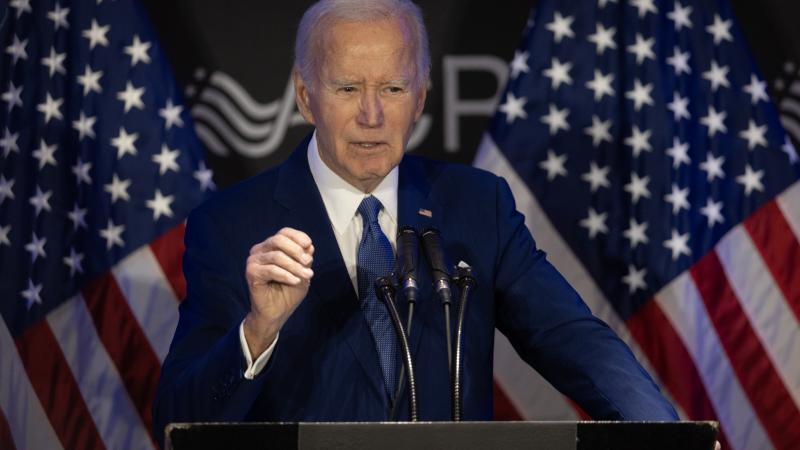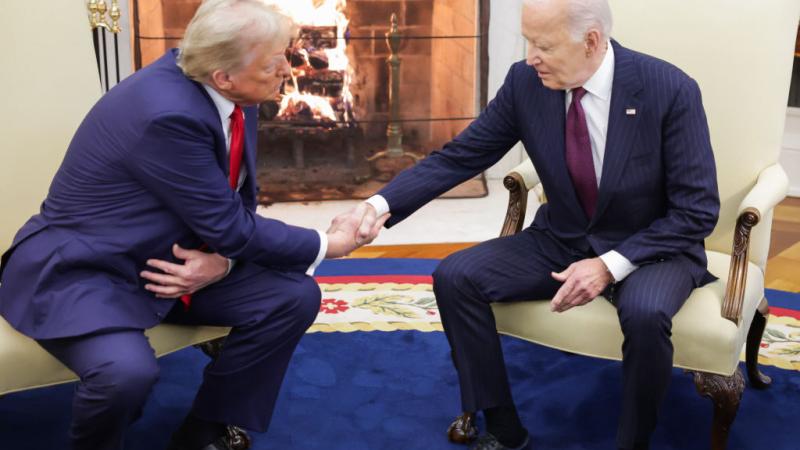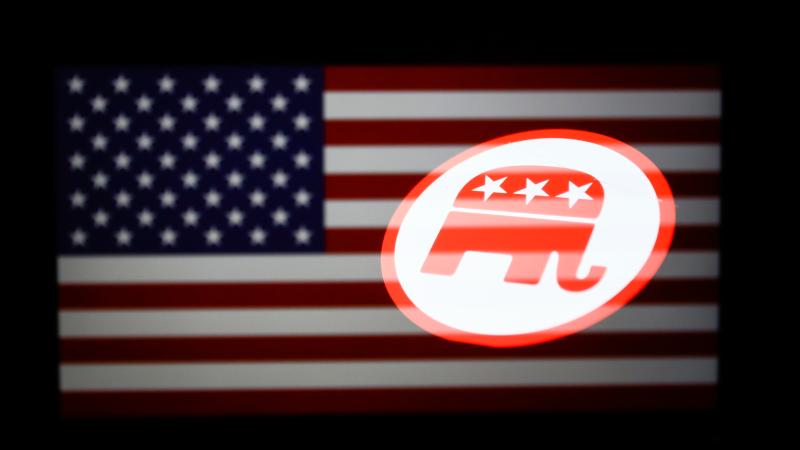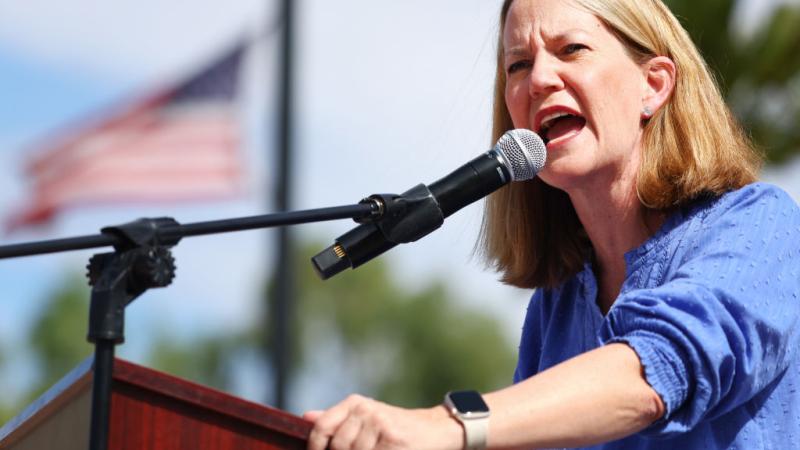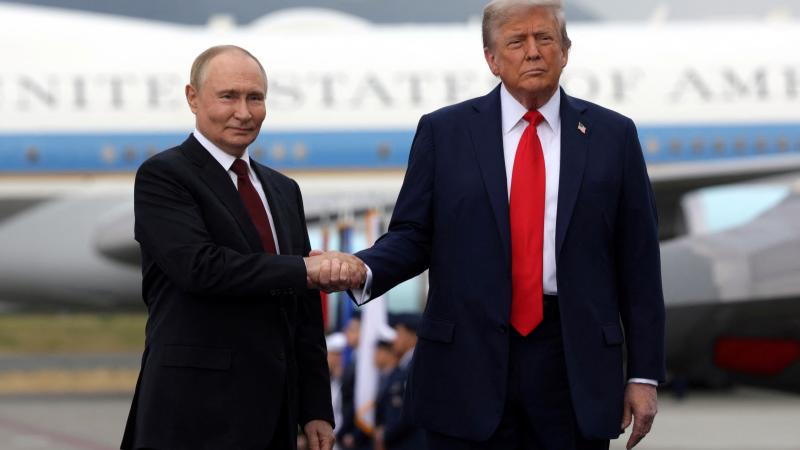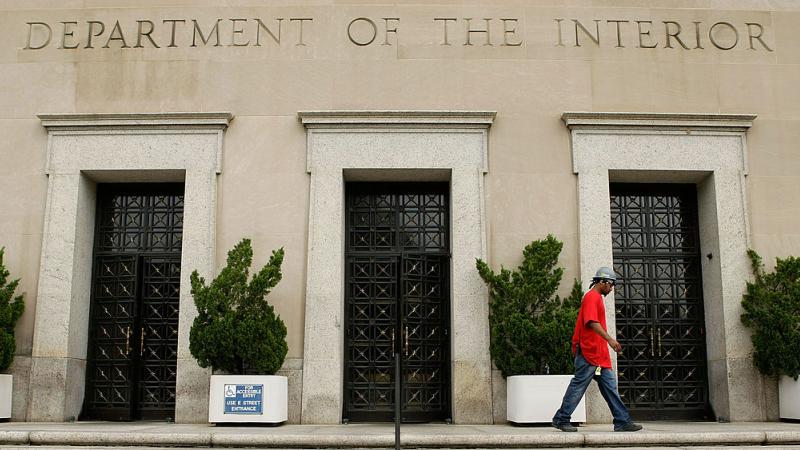Trump and Gabbard 'on the same page' as POTUS argues Iran was 'very close' to nuke, official says
Israel's existence at stake? Tulsi Gabbard says that she and Donald Trump are on the same page about the Iranian regime being close to obtaining a nuclear weapon. The Israelis obviously feel the danger is much more proximate.
President Donald Trump and his Director of National Intelligence Tulsi Gabbard are “on the same page” related to assessments of how close the Iranian regime was to obtaining a nuclear weapon, a senior Trump administration official insisted to Just the News, as Trump argued on Tuesday that the Iranians were “very close” to obtaining atomic weaponry.
Trump told reporters on Air Force One yesterday that he believed the Iranians had been “very close” to getting a nuclear weapon prior to the Israeli air strikes which began hammering Iranian nuclear facilities and the Israeli targeting of Iranian nuclear scientists starting late last week.
When a reporter contended that Gabbard had testified in March that the U.S. intelligence community was not building a nuclear weapon, Trump replied in the early hours of Tuesday morning that “I don’t care what she said, I think they were very close to having one.”
Confusion about what "close" means
The Office of the Director of National Intelligence (ODNI) — which oversees the U.S. intelligence community’s many agencies and which is led by Gabbard — released its Annual Threat Assessment (ATA) report in March which stated in part that “we continue to assess Iran is not building a nuclear weapon and that [Iranian Supreme Leader Ali Hosseini] Khamenei has not reauthorized the nuclear weapons program he suspended in 2003, though pressure has probably built on him to do so.”
The ODNI assessment added that “in the past year, there has been an erosion of a decades-long taboo on discussing nuclear weapons in public that has emboldened nuclear weapons advocates within Iran’s decision-making apparatus. Khamenei remains the final decision maker over Iran’s nuclear program, to include any decision to develop nuclear weapons.”
A senior administration official who asked to remain anonymous to discuss sensitive intelligence told Just the News that “the DNI and POTUS are on the same page.” The official said that Gabbard never said Iran isn’t close to obtaining a nuclear weapon, and argued that the assessment in March saying they’re at the highest enrichment levels and they’re lifting their decades long taboo of discussing nuclear weapons means they’re as close as they want to be.
The official also said that the distinction folks are making here is apples to oranges, especially when you look at her full ATA testimony instead of just the one line.
Gabbard had testified before the Senate Intelligence Committee on March 25 where she largely echoed the findings of the ATA report.
“The IC continues to assess that Iran is not building a nuclear weapon and Supreme Leader Khamanei has not authorized the nuclear weapons program he suspended in 2003,” Gabbard told the Senate. “The IC is closely monitoring if Tehran decides to reauthorize its nuclear weapons program. In the past year, we have seen an erosion of a decades-long taboo in Iran on discussing nuclear weapons in public, likely emboldening nuclear weapons advocates within Iran's decision-making apparatus. Iran's enriched uranium stockpile is at its highest levels and is unprecedented for a state without nuclear weapons.”
Gabbard delivered an identical assessment on the Iranian nuclear weapons program during testimony the next day before the House Intelligence Committee. The transcript of those March 26 remarks on the ODNI website incorrectly states that Gabbard referred to “Khomeini” — which would presumably be a reference to the Iranian regime’s first Supreme Leader, Ruhollah Musavi Khomeini, who took charge of revolutionary Iran in 1979 and died in 1989 — but a review of the video shows Gabbard correctly said “Khameini” in both her Senate and House testimonies.
A separate senior U.S. official, who also requested anonymity, told Just the News on Tuesday that at the highest levels of the U.S. government, he believes that Iran is as close to having a nuclear weapon as one can get.
Netanyahu: Iranian enrichment "a clear and present danger"
Last week, Israeli Prime Minister Benjamin Netanyahu announced the start of Operation Rising Lion, as Israeli jets and drones did significant damage to Iranian nuclear facilities, ballistic missile sites, drone production factories, and military compounds as the Israelis also targeted Iranian military and intelligence officials and nuclear scientists — all with the seeming acquiescence, although not the direct participation, of Trump and the U.S. military.
When announcing the strikes last Thursday, Netanyahu contended that “in recent years, Iran has produced enough highly-enriched uranium for nine atom bombs — nine” and that “in recent months, Iran has taken steps that it has never taken before — steps to weaponize this enriched uranium.”
Netanyahu argued that “if not stopped, Iran could produce a nuclear weapon in a very short time — it could be a year, it could it could be within a few months, less than a year. This is a clear and present danger to Israel’s very survival.”
The Israeli leader said that “this operation will continue for as many days as it takes to remove this threat.”
ODNI’s shift on Iran in past year
For half a decade starting in early 2019 through early 2024, ODNI repeatedly argued in its annual threat assessments that “we continue to assess that Iran is not currently undertaking the key nuclear weapons-development activities we judge necessary to produce a nuclear device.” This was the exact line used by ODNI in January 2019, April 2021, February 2022, February 2023 and June 2023, and February 2024.
But there was a shift by ODNI in July 2024, where the intelligence community’s lead off dropped that language and instead assessed that “since 2020, Iran has repeatedly stated that it is no longer constrained by any Joint Comprehensive Plan of Action (JCPOA) limits, expanded its nuclear program, reduced International Atomic Energy Agency (IAEA) monitoring, and undertaken activities that better position it to produce a nuclear device, if it chooses to do so.”
And then came the Gabbard-led ODNI’s assessment earlier this year, which said that Iran was not building a nuclear weapon and that Khamenei had not reauthorized the nuclear weapons program, but that pressure was building on him to do so and that the erosion of the decadeslong taboo on discussing nuclear weapons in public had empowered pro-atom bomb advocates inside the Iranian regime.
“Tehran will try to leverage its robust missile capability and expanded nuclear program, and its diplomatic outreach to regional states and U.S. rivals to bolster its regional influence and ensure regime survival,” the ODNI assessment in March also said.
“However, regional and domestic challenges, most immediately tensions with Israel, are seriously testing Iran’s ambitions and capabilities. A degraded Hizballah, the demise of the Assad regime in Syria, and Iran’s own failure to deter Israel have led leaders in Tehran to raise fundamental questions regarding Iran’s approach.”
Gabbard insists she and Trump were saying the same thing
The International Atomic Energy Agency (IAEA) assessed last week that “Iran's many failures to uphold its obligations since 2019 to provide the Agency with full & timely cooperation regarding undeclared nuclear material & activities at multiple undeclared locations in Iran… constitutes non-compliance.”
CNN reported on Tuesday that “U.S. intelligence assessments had reached a different conclusion” from the one reached by Israel — “not only was Iran not actively pursuing a nuclear weapon, it was also up to three years away from being able to produce and deliver one to a target of its choosing.” The outlet cited “four people familiar with the assessment.”
Gabbard also told CNN on Tuesday that “Trump was saying the same thing that I said in my annual threat assessment back in March. Unfortunately too many people in the media don't care to actually read what I said.”
“No one said making weapons, he said they are ‘very close.’ Just because they’re not building right now, doesn’t mean they aren’t ‘very close’ as he said on Air Force One,” Alexa Henning, the ODNI deputy chief of staff, said on X.
“All of the other points the DNI made assess them being very close to building one. i.e ‘highest enrichment levels’ and ‘erosion of a decades-long taboo in Iran on discussing nuclear weapons in public, likely emboldening nuclear weapons advocates within Iran's decision-making apparatus.’ POTUS and the DNI are congruent.”
White House stands firm on its assessment
The White House doubled down on Trump’s assessment that Iran was “very close” to getting nuclear weapons in a series of posts on Tuesday.
The Rapid Response 47 account, which says it is the "Official Rapid Response account of the Trump 47 White House," shared the video of Trump revealing his assessment to reporters. The official Trump White House account on X retweeted the video. The White House-aligned rapid response account also retweeted Gabbard’s statement that Trump was saying the same thing as she had said in March.
The account also posted a portion of Kurilla’s testimony from last week when he warned about Iran’s ability to rapidly achieve a nuclear breakout.
“President Donald J. Trump has never wavered in his stance that Iran cannot be allowed to have a nuclear weapon — a pledge he has made repeatedly, both in office and on the campaign trail,” the White House also emphasized on Tuesday.
The White House then listed dozens of examples where Trump — as a private citizen, as a candidate, and during both of his terms as president — declared that Iran must not be allowed to obtain nuclear weapons capabilities.
Vice President JD Vance also weighed in on Tuesday with a lengthy post on X where he suggested that Iran had been moving toward a nuclear weapon. “It's one thing to want civilian nuclear energy. It's another thing to demand sophisticated enrichment capacity. And it's still another to cling to enrichment while simultaneously violating basic non-proliferation obligations and enriching right to the point of weapons-grade uranium,” Vance said.
“I have yet to see a single good argument for why Iran needed to enrich uranium well above the threshold for civilian use. I've yet to see a single good argument for why Iran was justified in violating its non-proliferation obligations. I've yet to see a single good pushback against the IAEA's findings.”
Sounding the alarm
General Michael “Erik” Kurilla, the commander of U.S. Central Command (CENTCOM), testified before the Senate Armed Services Committee on Tuesday of last week, just a few days before Israel began its significant strikes against the Iranian nuclear program. Kurilla said that Iran’s massive aerial attacks against Israel in April and October of last year were “defeated” by missile defenses deployed by the Israelis and by the U.S. and regional allies, and that “Iran then suffered a devastating counterattack by the Israeli Air Force, which easily penetrated Iranian airspace and destroyed their strategic air defense, exposing the Regime and laying bare their weakness.”
The CENTCOM commander also said that “while Iran retains thousands of ballistic missiles and attack drones that threaten every American base and every partner in the Region, these experiences have forced Iran to reassess its approach to projecting power.”
“Iranian leadership understands their acute vulnerability, and the precision of Israel’s response demonstrates that Iran will remain critically exposed to future Israeli operations, even if their former defenses are reconstituted,” Kurilla said last week. “Significantly weakened, Iran finds itself with fewer options. In addition to an active chemical weapons program, there is one remaining pillar the Regime may consider its best chance at restoring deterrence and imposing its will on the Region — the threat of developing a nuclear weapon.”
Kurilla then sounded the alarm on Iran’s ability to potentially produce ten nuclear weapons quickly.
“The IAEA uses 90% enrichment as the benchmark for weapons-grade uranium, and it considers 25 kg of 90% enriched uranium enough to construct a simple nuclear weapon. The IAEA estimates current Iranian stockpiles to include over 400 kg of 60% enriched uranium — almost double of what it was just six months ago,” the CENTCOM chief said. “This is mere steps from reaching the 90% threshold for weaponization. Should the Regime decide to sprint to a nuclear weapon, it is estimated that current stockpiles and the available centrifuges across several enrichment plants are sufficient to produce its first 25 kg of weapons-grade material in roughly one week and enough for up to ten nuclear weapons in three weeks.”
General Dan Caine, the new chairman of the Joint Chiefs of Staff, told senators that his assessment of the Iranian regime was that “I think they would, potentially” use a nuclear weapon against Israel if the Iranians obtained one, adding, "I think they'd use it to pressure Israel. I don't know whether they would use it.”
Secretary of Defense Pete Hegseth appeared before the Senate Appropriations Defense Subcommittee on Wednesday last week — the day before Israel’s strikes on Iran. Hegseth was asked if the Iranians were building a nuclear weapon, and he told the senators that “there are plenty of indications that they have been moving their way towards something that would look a lot like a nuclear weapon.”
When asked, the defense secretary added that "I believe they mean what they chant” when the Iranians chant about killing Jews. Hegseth said the Israelis “believe quite understandably” that the Iranians would use a nuclear weapon to wipe out the state of Israel.
Cotton: "Iran's work Confirmed"
Sen. Tom Cotton, R-Ark., the chairman of the Senate Intelligence Committee, tweeted last Wednesday that Hegseth had “confirmed that Iran’s terrorist regime is actively working towards a nuclear weapon” and that “for the sake of our national security, the security of our allies, and millions of civilians in the region this cannot be allowed to happen.”
Cotton tweeted on Thursday, after the Israeli strikes against Iran had begun, that “Iran is the world’s worst state sponsor of terrorism, has the blood of thousands of Americans on its hands, and is rushing to build not only nuclear weapons, but also missiles that can strike the United States.”
The Senate chairman then told Face the Nation on Sunday that “unfortunately, Iran enriched a lot of the uranium to near weapons-grade over the four years of the Biden administration” and argued that the Iranians “are close to having enough pure weapons-grade uranium for several weapons.”
“Now, that's not the only step to having a weapon. You also have to have the weapon design. We've seen indications that Iran is once again exploring those weapon designs. And then, if you want to use a missile, obviously, you have to marry up the warhead to the missile. But Iran has other delivery methods as well, through terrorist proxies,” Cotton said.
“So I think that's one of the reasons why both President Trump and Prime Minister Netanyahu thought … things that were coming to a head. A second reason is, Iran is rapidly producing ballistic missiles, both medium-range to target Israel and short-range to target our troops, and they add substantially to those stockpiles every single month.”
Cotton concluded that Israel likely struck Iran when it did because “at a time when Iran is both continuing its work on its nuclear program and trying to rebuild its offensive missile capacity, that the window to actually stop Iran from entering that zone of immunity was rapidly closing.”
Netanyahu: "We are at midnight"
Netanyahu defended the decision to strike Iran during a Friday video, arguing that “if we don’t attack, then it’s 100% that we will die,” according to the Times of Israel. Netanyahu said that Israeli intelligence showed that the Iranians were on the verge of obtaining nuclear weapons, saying that “we decided we couldn’t wait anymore — we are at midnight.”
The Israeli prime minister said that he had given the order to take out the Iranian nuclear program in November after he believed it had become clear that Iran would move quickly to build a nuclear weapon after its Hamas and Hezbollah proxies had been debilitated by Israel.
“The directive came shortly after the assassination of [Hezbollah leader Hassan] Nasrallah,” Netanyahu said, arguing that Iran would speed toward an atomic weapon once Hezbollah could no longer threaten Israel.
“We were facing an imminent threat — a dual existential threat,” Netanyahu told Fox News on Sunday. “One, the threat of Iran rushing to weaponize their enriched uranium to make atomic bombs with the specific and declared intent to destroy us. Second, a rush to increase their ballistic missile arsenal. … We had to act. It was the twelfth hour.”
Netanyahu continued, saying, “The intel we got and we shared with the United States was absolutely clear — was absolutely clear — that they were working, in a secret plan, to weaponize the uranium. They were marching very quickly. They would achieve a test device and possibly an initial device within months, and certainly less than a year. That was the intel we shared with the United States. I think we have excellent intel in Iran — I think we’ve proven that — and that is something that we couldn’t possibly accept.”
Israel relies on "Golden Information" justifying airstrikes
New details on Israel’s alleged intelligence on the Iranian nuclear program were revealed by the Times of Israel over the weekend.
“Ahead of its strikes on Iran, Israel discovered that the Islamic Republic’s scientists had conducted successful experiments in the design process of a nuclear weapon, bringing it weeks away from being able to produce a bomb if it chose to do so, according to a Hebrew media report Sunday,” the outlet said. “This ‘golden information’ was presented by intelligence officials to the political leadership before the decision was made to carry out preemptive strikes Friday, along with the concern that Israel didn’t know everything and that Tehran could be at an even more advanced stage in building a nuclear bomb than the available information showed." The newspaper quoted Israeli Army Radio, citing unnamed security officials.
Yair Lapid, the leader of the Israeli political opposition to Netanyahu since 2023, wrote an opinion piece for the Jerusalem Post on Sunday saying that he agreed with Netanyahu’s assessment of the Iranian nuclear program and with his decision to strike at it.
The Iranian regime’s efforts to “advance its nuclear program and work to build an arsenal of nuclear weapons that would be fired with ballistic missiles” were not a hypothetical, but were “already happening.”
"Netanyahu is my political rival, but his decision to strike Iran at this moment in time is the right one. The whole country is united in this moment, when faced with an enemy sworn to our destruction, nothing will divide us,” Lapid wrote.
“We went to war for the only reason that justifies war — we had no choice. A nuclear Iran would have been an existential threat to the State of Israel. Iran cannot be a nuclear state. Not now. Not ever.”
The Facts Inside Our Reporter's Notebook
Links
- told reporters
- released its Annual Threat Assessment (ATA) report
- Israeli jets
- seeming acquiescence
- direct participation
- contended
- testified
- transcript
- video
- January 2019
- April 2021
- February 2022
- February 2023
- June 2023
- February 2024
- instead assessed
- assessment
- assessed
- reported
- also told
- said
- shared
- posted
- emphasized
- weighed in
- sought to undermine
- assassination attempts
- testified
- appeared
- tweeted
- tweeted
- told
- defended
- told
- revealed
- opinion piece

